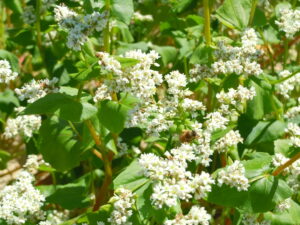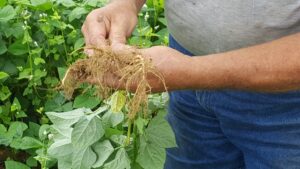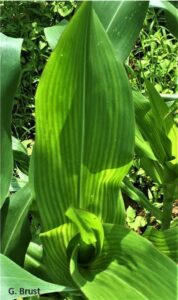The Northeast Cover Crops Council will host a fall webinar series. The webinars will take place from 12-1 pm on Wednesdays from October 1 to November 5, 2025. Click here to register for the series. [Read more…]
What Can Summer Cover Crops Do for Soil Health and Future Crops?
 Now that some of our spring planted crops have finished, rather than leaving fields fallow or replanting fields that may have had some issues with plant diseases or insect pests, consider replanting with a summer cover crop. It is not too late to take advantage of summer cover crop benefits. What do summer cover crops do for soil health or future crop improvements? See below:
Now that some of our spring planted crops have finished, rather than leaving fields fallow or replanting fields that may have had some issues with plant diseases or insect pests, consider replanting with a summer cover crop. It is not too late to take advantage of summer cover crop benefits. What do summer cover crops do for soil health or future crop improvements? See below:
1. Increase Soil Organic Matter– One of the best attributes of having organic matter in the soil is improvement in soil structure. Adding organic matter improves tilth, water infiltration, water holding capacity, nutrient holding capacity and reduction of soil crusting. Also, as important is the increase in beneficial soil microbes and earthworms. Beneficial microbes can compete with pathogens and help release nutrients. Earthworms can cycle nutrients and improve pore spaces in the soil.
2. Reduce Soil Erosion – Just like with winter cover crops, summer cover crops can also reduce wind and water erosion in fields, especially those with slopes. During summer rainfall events, that can be significant if resulting from tropical storms, runoff may not just include soil loss, but also fertilizer and chemical movement. Therefore, keeping cover on a field during non-production times in any season is an excellent practice.
3. Nitrogen Cycling in the Soil – Nitrogen is often the most limiting nutrient for crop production, since it is so readily lost through nitrification and leaching. Storing nitrogen through plant cycling is an excellent way to improve fertility management. Whether it is a grass or non-leguminous cover crops N is still kept in the mix by the cover crop taking up residual N that would otherwise be lost. The cover crop plant takes up the nitrogen and after the crop is incorporated it decomposes, thus releasing the N for subsequent crops to use. If legume cover crops are planted, they have the ability to “fix” nitrogen from the atmosphere and through the same decomposition process will provide N for subsequent crops. Be sure to inoculate legume seed just prior to planting with Rhizobium bacteria in order to gain the maximum N fixation benefits.
otherwise be lost. The cover crop plant takes up the nitrogen and after the crop is incorporated it decomposes, thus releasing the N for subsequent crops to use. If legume cover crops are planted, they have the ability to “fix” nitrogen from the atmosphere and through the same decomposition process will provide N for subsequent crops. Be sure to inoculate legume seed just prior to planting with Rhizobium bacteria in order to gain the maximum N fixation benefits.
4. Reduce Weeds – When fields are left fallow after crops are harvested, weed growth can occur. If left to produce seeds, these weeds will multiply in subsequent crops. Therefore, managing the field by planting cover crops between cash crops is a great weed management option. As the cover crop grows, it will suppress the germination and growth of weeds through competition and shading. Some cover crop species can also suppress weeds biochemically, either while they are growing or while they are decomposing, which may prevent the germination or growth of other plants (allelopathy). Research has shown some cover crops like wheat, barley, oats, rye, sorghum, and sudangrass may suppress weeds. In some cases, it has also been reported that residues and leachates from crimson clover, hairy vetch, and other legumes have shown weed suppression.
5. Impacts on Plant Diseases – Cover crop residues could possibly be beneficial when it comes to plant pathogens, or can in some cases increase plant disease organisms. Some cover crop species are in the same plant families as cash crops and may be susceptible to the same disease organisms. Therefore, carrying the pathogen to the next crop. This is why paying attention to crop rotations is so important. In other cases, the cover crop residue can improve soil health in order to produce a better environment for beneficial microbes. By improving soil health, water infiltration, air pore space and other positive attributes, some soil pathogens may not survive as well, as in the case of water molds and water fungi. Some cover crops, like sorghum-sudangrass and sunnhemp, have been reported to reduce nematodes in soils. There are multiple positive factors from cover crops that can combat plant diseases.
6. Impacts on Insects – Like with plant diseases, cover crops can be susceptible to the same insect pests as cash crops. However, they may also attract beneficial insects into an area. Insect pests should be monitored in cover crops, just like in cash crops in order to not let populations get out of control and then move into nearby fields after the cover crop is killed.
For more resources on the us e of cover crops check out these resources: Cover Crops for Sustainable Crop Rotations – SARE
Rutgers Soil Testing Laboratory adds Sulfur to Soil Fertility Analysis
Plant-available sulfur (sulfate) values have been added to Rutgers Soil Testing Laboratory fertility reports in the micronutrient reporting line. There are four interpretive categories: Low, Medium-low, Sufficient, and High. An explanatory paragraph follows near the end of the report to help interpret the reported value.

Symptoms of sulfur deficiency include yellowing or light green coloring on youngest tissue, thin stems and petioles, slow growth, and delayed maturity. Photo Credit: G. Brust, University of Maryland.
As the interpretative statements within the reports explain, sulfur analysis/interpretation is very complicated (similar to nitrogen) due to the many factors influencing it. Also, there is not full consensus among soil fertility experts on a best extraction method and critical values. Still, the sulfur value on the revised reports will provide an extra degree of information for understanding the soil & plant health. As with all micronutrient interpretations on the reports, the relevant RCE publication is referenced for further information; in the case of sulfur, RCE bulletin E365.
Register today for NE Cover Crops Council Annual Conference!
The Northeast Cover Crops Council Annual Conference will take place next week on Thursday, March 10 and Friday, March 11, 2022. The conference will be held virtually from 9 a.m. to 12:30 p.m. on both days. Find the full agenda here! Registration will close on Monday, March 7 at noon. [Read more…]
2022 Northeast Cover Crops Council Conference
Registration for the 5th Annual Northeast Cover Crops Council Conference is now open!
The conference will be held virtually from 9 a.m. to 12:30 p.m. on two days – Thursday, March 10 and Friday, March 11, 2022. The agenda includes graduate student lightning talks and several concurrent sessions led by researchers, Extension and industry personnel and agricultural producers from throughout the country. Find the full agenda here! [Read more…]
Impacts of Pesticides on Soil Health – Part II?
Disinformation, misinformation, bad science, bad reporting… the public is becoming more aware that one of the toughest challenges faced these days is sorting out what is good reporting (and good science), versus what is misleading or untruthful. It seems ironic that after my post yesterday, the following article showed up in my inbox this morning – Perspective: This pesticide ‘research’ is short on data, big on hype .
In this post, the author, farmer-agronomist Jack DeWitt, critiques a commentary in Scientific American magazine that promotes a ‘study’ conducted by the same authors of the commentary, who happen to be the director and research assistant at the non-profit Center for Biological Diversity, an organization with a stated agenda. Their ‘analysis’ published online in Frontiers in Environmental Science appears to be a legitimate review of previous scientific studies concerning the effects of ‘pesticides’ on soil organisms, again the current often-cited gauge of “soil health”, though in this case they focused only on soil invertebrates (worms and insects, basically) and ignored fungi and bacteria.
Standard scientific journal formats require ‘materials and methods’ sections so that one can read how a study was conducted and determine if the results are analyzed and conclusions drawn appropriately from the data and how that was collected. If properly reviewed in the pre-publication stage, poorly conducted studies and/or inappropriate conclusions would be cause for rejection of the manuscript, or at least would require a significant revision and/or further explanation of how the data supports the conclusions. Scientists reading articles with such flaws scratch their heads in wonder how they were published, and in very rare cases, if there is enough negative reaction citing improper methodology, analysis and/or conclusions, an article is recanted after publication. In this case, going back to the original scientific review, DeWitt illustrates how carefully selected data are misinterpreted and/or misrepresented to support the authors’ cause, er … conclusions.
Moral of the story… don’t take scientific reporting as gospel, even from respected media outlets, until you consider the source, the funding, and take a careful look at the original article, if it’s available.
